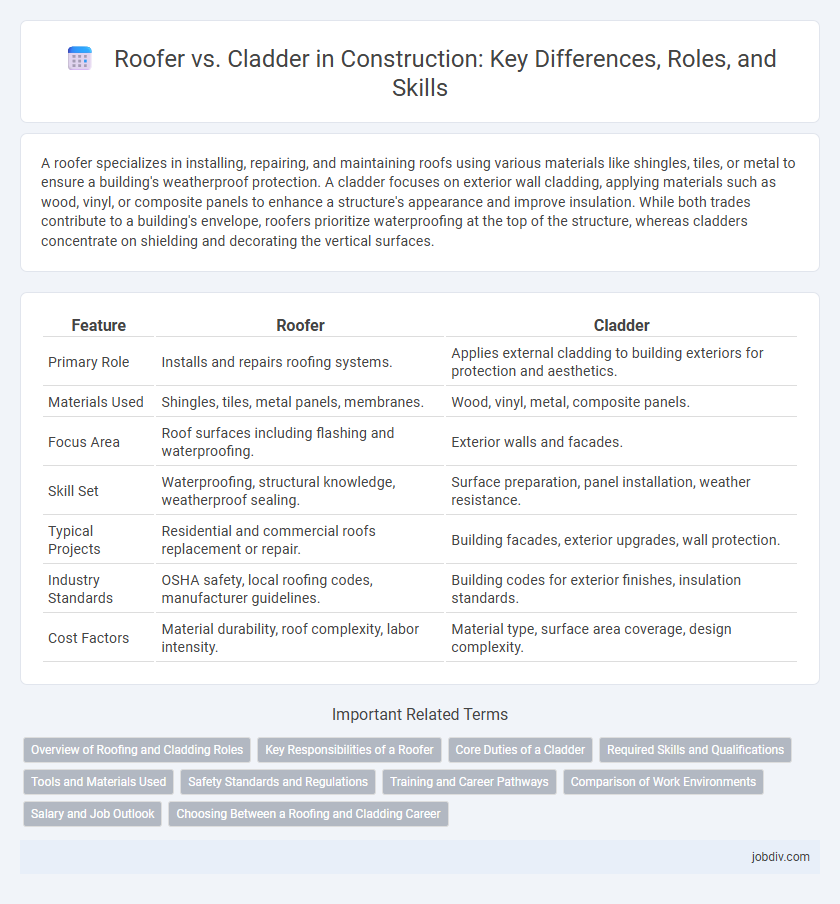A roofer specializes in installing, repairing, and maintaining roofs using various materials like shingles, tiles, or metal to ensure a building's weatherproof protection. A cladder focuses on exterior wall cladding, applying materials such as wood, vinyl, or composite panels to enhance a structure's appearance and improve insulation. While both trades contribute to a building's envelope, roofers prioritize waterproofing at the top of the structure, whereas cladders concentrate on shielding and decorating the vertical surfaces.
Table of Comparison
| Feature | Roofer | Cladder |
|---|---|---|
| Primary Role | Installs and repairs roofing systems. | Applies external cladding to building exteriors for protection and aesthetics. |
| Materials Used | Shingles, tiles, metal panels, membranes. | Wood, vinyl, metal, composite panels. |
| Focus Area | Roof surfaces including flashing and waterproofing. | Exterior walls and facades. |
| Skill Set | Waterproofing, structural knowledge, weatherproof sealing. | Surface preparation, panel installation, weather resistance. |
| Typical Projects | Residential and commercial roofs replacement or repair. | Building facades, exterior upgrades, wall protection. |
| Industry Standards | OSHA safety, local roofing codes, manufacturer guidelines. | Building codes for exterior finishes, insulation standards. |
| Cost Factors | Material durability, roof complexity, labor intensity. | Material type, surface area coverage, design complexity. |
Overview of Roofing and Cladding Roles
Roofers specialize in installing and repairing roofing systems, focusing on materials such as shingles, tiles, and metal to ensure waterproof and durable roof structures. Cladders are responsible for the external envelope of buildings, applying protective and decorative panels like metal, timber, or composite materials to walls for weather resistance and aesthetic appeal. Both roles require knowledge of weatherproofing, insulation, and structural integrity to enhance building performance and longevity.
Key Responsibilities of a Roofer
Roofers specialize in installing, repairing, and maintaining various types of roofing systems including asphalt shingles, metal, and flat roofs. Their key responsibilities involve assessing roof damage, applying waterproofing materials, and ensuring proper insulation to prevent leaks and structural issues. Roofers also work closely with safety regulations to manage height risks and secure roofing materials effectively.
Core Duties of a Cladder
Cladders specialize in installing external building envelopes, including metal panels, stone, and composite materials, providing weatherproofing and aesthetic finishes. Their core duties involve measuring, cutting, and fitting cladding materials to ensure structural integrity and energy efficiency. Unlike roofers who focus primarily on waterproof roof coverings, cladders enhance building facades while contributing to insulation and durability.
Required Skills and Qualifications
Roofers must have expertise in installing and repairing various roofing materials such as shingles, tiles, and metal sheets, along with strong knowledge of safety protocols and waterproofing techniques. Cladders require proficiency in applying exterior wall coverings including metal panels, stone, and vinyl siding, emphasizing precision in measurements and weatherproof sealing. Both trades demand physical stamina, familiarity with construction tools, and the ability to read blueprints, but roofers often need certification in fall protection, while cladders benefit from skills in thermal insulation installation.
Tools and Materials Used
Roofers primarily use tools such as nail guns, roofing hammers, roofing knives, and shingle cutters, working with materials like asphalt shingles, metal roofing, clay tiles, and rubber membranes. Cladders utilize tools including scaffolding, power washers, drills, and various fastening systems to install cladding materials like vinyl, fiber cement, wood, stone veneer, and metal panels. Both trades require specialized safety equipment and precision tools tailored to their specific installation processes and material handling.
Safety Standards and Regulations
Roofers and cladders must adhere to strict safety standards and regulations to prevent falls and injuries, including the use of personal protective equipment (PPE) such as harnesses and helmets. Compliance with OSHA regulations and local building codes ensures safe working conditions when installing or repairing roofing materials or exterior cladding systems. Regular safety training and site inspections are critical in minimizing hazards associated with elevated work environments common to both professions.
Training and Career Pathways
Roofers primarily undergo apprenticeships or vocational training in roofing techniques, safety standards, and material handling, enabling them to specialize in installing and repairing various roofing systems. Cladders focus on training programs centered on external wall insulation, weatherproofing, and facade installation, often requiring skills in working with diverse cladding materials such as metal, timber, and composites. Both career pathways offer opportunities for certification and advancement, with roofers progressing toward supervisory roles or specialized roofing disciplines, while cladders may evolve into facade consultants or project managers in building envelope systems.
Comparison of Work Environments
Roofers primarily work on sloped surfaces exposed to weather elements, requiring safety harnesses and specialized equipment to navigate heights. Cladders operate mostly on vertical building exteriors, often using scaffolding or lifts to install facade materials in varying weather conditions. Both professions demand physical endurance and adherence to safety protocols, but roofers face more direct exposure to extreme sun, wind, and precipitation while cladders frequently manage intricate detailing under similar environmental challenges.
Salary and Job Outlook
Roofers typically earn a median annual salary of around $45,000, with job growth projected at 8% over the next decade, reflecting steady demand for roof installation and repair. Cladders, specializing in installing exterior wall coverings, command slightly higher median wages of approximately $50,000 and face a similar job outlook driven by new building projects and facade renovations. Both roles require physical labor and precision, but cladders often benefit from a broader range of materials expertise, influencing their competitive compensation and steady employment prospects.
Choosing Between a Roofing and Cladding Career
Choosing between a roofing and cladding career depends on skill sets and market demand. Roofers specialize in installing and repairing various roofing materials such as shingles, tiles, and metal, requiring expertise in weatherproofing and structural integrity. Cladders focus on exterior wall systems, emphasizing insulation, aesthetics, and protection against environmental elements, making their work crucial for building envelope performance.
Roofer vs Cladder Infographic

 jobdiv.com
jobdiv.com